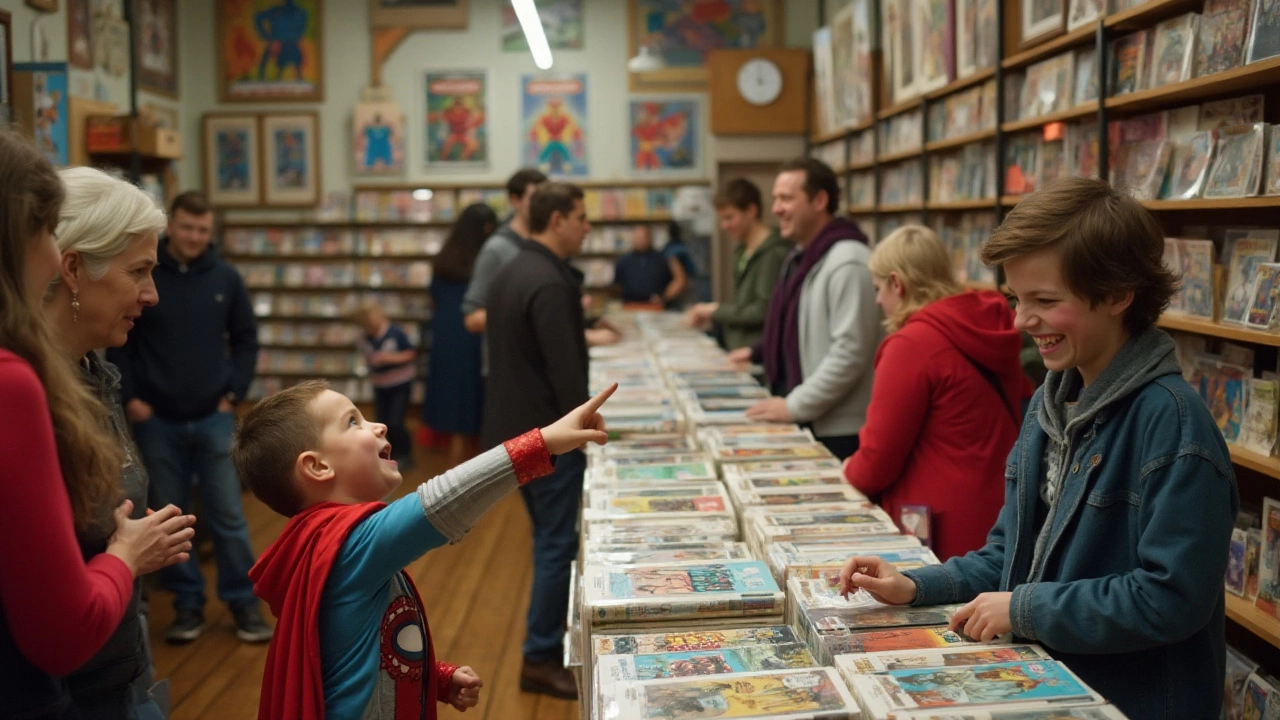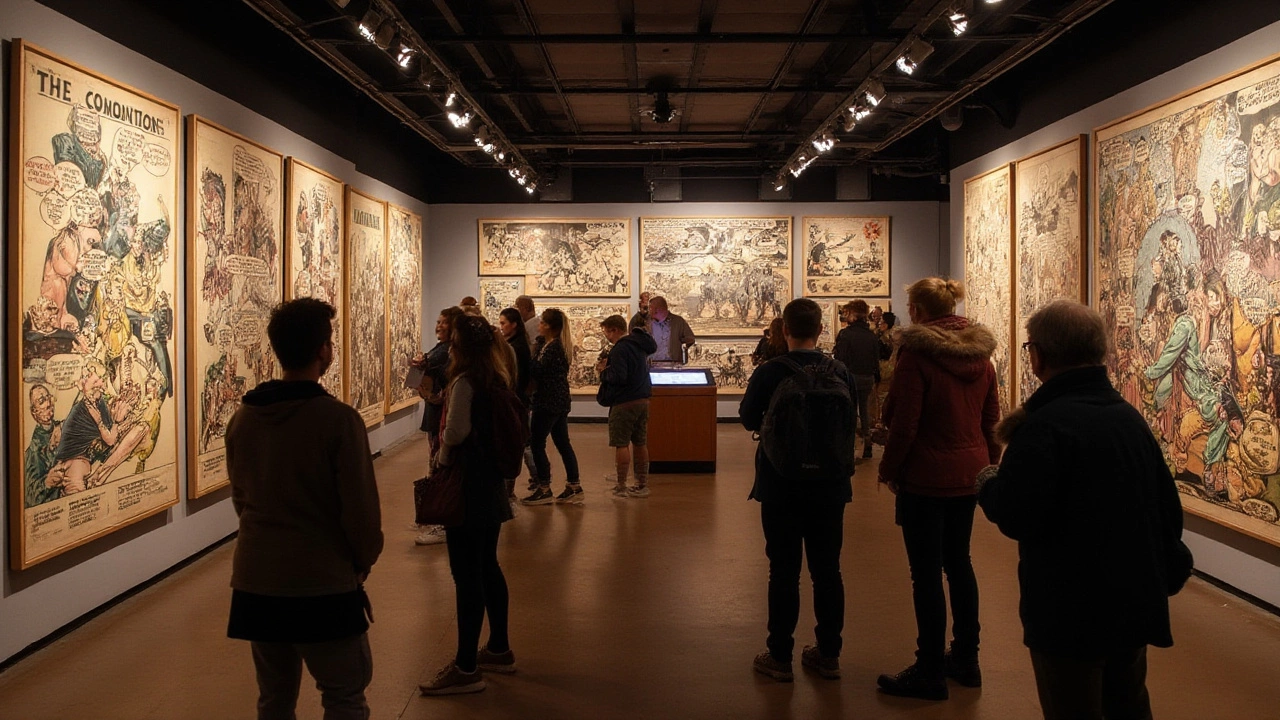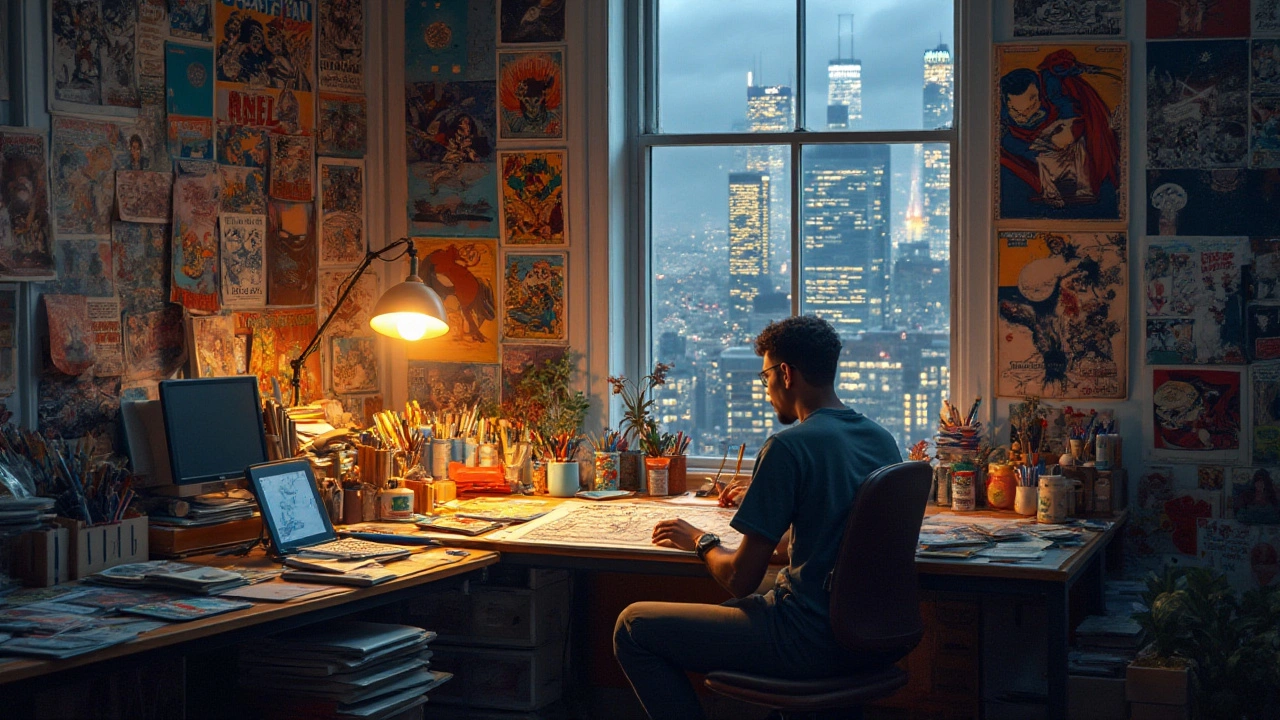Comics, often referred to as the '9th Art,' hold a unique position in the world of contemporary art. This art form combines visuals and text in a way that is both engaging and expressive, creating a storytelling medium unlike any other.
The term '9th Art' emerged to acknowledge the artistic merit of comics, recognizing their complex narratives and the skillful artwork embedded within. Over time, comics have evolved beyond their origins, playing a significant role in various cultures and becoming a source of inspiration for other art forms.
In this exploration, we take a closer look at how comics have developed as an art form, their cultural ramifications, and the innovative techniques that have shaped their existence. We'll also delve into some influential works and creators, illustrating the profound impact comics have globally.
- The Origin of the Term '9th Art'
- Evolution of Comics as Art
- Cultural Impact of Comics
- Artistic Techniques in Comics
- Notable Comics and Creators
- The Global Influence of Comics
The Origin of the Term '9th Art'
The phrase '9th Art' might seem enigmatic at first, yet it represents a significant acknowledgment of comics as a vital element of the broader arts dialogue. This term, '9th Art,' was birthed from a desire to classify comics formally among artistic disciplines. It first appeared in the 1960s when French critics began to recognize the potential of comics not just as a medium for entertainment, but as a formidable form of art worthy of intellectual discussion and critique. The intent was to situate comics within a hierarchy of the arts, with traditional forms like painting, sculpture, and architecture already well established over many centuries.
This newfound recognition did not happen overnight. It was a meticulous process of advocacy and analysis spearheaded by art historians, cultural critics, and passionate fans who saw the inherent artistic qualities in comics. They championed the unique storytelling capabilities of this blend of text and visuals, emphasizing how comics create an immersive experience that bridges conventional artistic boundaries. Their arguments centered around the idea that comics, with their sequential art, narrative depth, and stylistic diversity, demanded the same respect granted to classic forms of expression.
One of the pivotal figures in this movement was Pierre Couperie, a determined French scholar and one of the founding members of the Club des Bandes Dessinées in 1962. This club was committed to the serious study of comics, which in French are referred to as 'bandes dessinées.' Couperie's efforts, alongside those of his contemporaries, helped establish an intellectual foundation for comics. They organized conferences, published influential works, and curated exhibitions that showcased the potential and depth of comics as an art form. Their efforts were instrumental in changing public perception and setting the stage for the worldwide appreciation that comics enjoy today.
A key argument made by these advocates was the idea that comics represent a synthesis of various art forms. They combine aspects of literature, visual art, and even cinematic techniques, creating a hybrid medium capable of exploring complex emotions and themes. This inherent flexibility allows comics to tackle subjects ranging from the fantastical to the deeply personal, offering creators a versatile canvas on which to express their artistic visions. This versatility has made comics a powerful medium for social commentary and a reflection of cultural dynamics.
"Comics are a gateway into a new kind of storytelling, breaking the mold of traditional narratives," said famed comic book artist Will Eisner, further cementing the idea that comics are not merely pulp; they are the art of imagination itself.
In recognizing comics as the '9th Art,' this classification also sparked discussions and debates about the nature of art itself and its evolution. The very fact that comics had to fight for their place among the arts raises questions about the criteria we use to judge artistic worth and heralds the importance of continuous reassessment and redefinition of what art signifies in our societies. It's a discourse that encourages us to look beyond established norms and find value in new and emerging forms of expression.
As time progresses, comics continue to gain legitimacy within the artistic community, influencing contemporary art, literature, and popular culture. With international markets embracing graphic novels and adaptations reaching film and television, the impact of comics is undeniable. This recognition as the '9th Art' was not just an accolade but a prelude to the exploding popularity and dynamic evolution of this vibrant art form. Today, we celebrate comics not just as entertainment but as a complex, vibrant, and invaluable component of the global artistic tapestry.
Evolution of Comics as Art
The journey of comics from simple entertainment to a recognized form of contemporary art has been fascinating. The origins of comics can be traced back to the 19th century with the emergence of illustrated drawings and humorous strips in newspapers. Initially, these were simplistic cartoons, often used to satirize social and political issues. Over time, the art style and storytelling grew more sophisticated, paving the way for the birth of the comic book in the 1930s. These early comics featured colorful narratives and adventurous superheroes, capturing the imagination of audiences worldwide. The 1950s saw a pivotal moment as comics faced scrutiny over their content. This period catalyzed an evolution in both themes and artistic styles, as creators pushed boundaries to explore more profound and diverse stories.
By the 1960s and 1970s, comics had started to embrace more mature and diverse themes, driven in part by the cultural revolutions of the time. Underground comics emerged, influenced by counter-culture movements and artists who dared to challenge conventional norms. These comics often tackled controversial subjects and featured innovative art styles, contributing to the medium's prestige as a legitimate art form. Publications like Art Spiegelman's "Maus" in the 1980s marked a turning point, earning widespread acclaim for its intricate narrative that discussed historical events with a raw, emotional depth. Spiegelman's work cemented the potential of graphic novels as serious literary contenders, deserving of scholarly attention.
In recent decades, recognition of comics as the 9th Art has flourished, fueled by technological advancements and global cultural exchange. Digital platforms have enabled diverse voices from around the globe to share their work, leading to a blend of styles and themes unlike anything seen before. Today, comics have permeated other media, influencing films, television, and even video games, acting as a testament to their broad appeal and artistic value. "Comics are a gateway drug to literacy," as Neil Gaiman once said, reflecting their capacity to engage readers in unique and profound ways. This art form's evolution continues to captivate, challenge, and inspire both artists and audiences alike.

Cultural Impact of Comics
Comics have long held an influential role in shaping and reflecting culture around the globe. Originating as entertainment for children and adolescents, these striking combinations of words and pictures have transcended their initial purpose; they now resonate powerfully across age groups and cultures. Comics are not merely entertainment; they are a potent cultural force that reflects society's values, challenges its norms, and inspires change. The birth of vividly drawn, and deeply narrative-driven graphic stories gave rise to what is now recognized as the 9th art. From innovations in storytelling to the championing of bold narratives, comics have amplified voices that might not have been heard in traditional media. Characters like Superman and Wonder Woman sprung from clear post-war mentalities, advocating ideals of justice and moral righteousness that served as beacons of hope in tumultuous times. Today, the presence of characters with diverse backgrounds and experiences mirrors the rich tapestry of human society, fostering inclusivity and encouraging conversations about race, gender, and identity.
The artistic techniques and compelling narratives unique to comics have stimulated cultural growth beyond the boundaries of print. Many films, television shows, and video games draw heavily from the narratives and characters of beloved graphic novels, helping to cement a mainstream acceptance of what was once considered a niche interest. The Marvel and DC Comics franchises stand as prime examples, their cinematic universes reaching global audiences and proving the translation and impact potential of comic-based storytelling. These adapted stories do more than entertain; they become cultural phenomena that spark dialogues across various media platforms, showcasing the significance of comics in contemporary art and culture.
"Comics are stories; they are narratives told by means of pictures," asserts Will Eisner, a visionary whose work has solidified comics as a respected art form.
Beyond the entertainment industry, the influence of comics permeates political discourse and educational frameworks. Comic strips and graphic novels have been adopted by educators to help students engage with complex topics ranging from historical events to scientific concepts. The mix of visuals and text makes learning both more approachable and engaging, providing an alternative method to traditional educational resources. Comics like "Maus" and "Persepolis" are prime examples, offering poignant historical and cultural commentary through the medium of the 9th art. This innovative teaching practice underscores the cultural significance of comics, showcasing how they can be tools for education and change.
In recent years, there's been a notable rise in the presence and celebration of comic conventions worldwide, such as San Diego Comic-Con, which attracts legions of fans and professionals who share an enthusiasm for this contemporary art form. These gatherings not only celebrate the artistry but build communities united by their passion, contributing to a larger acceptance and understanding of the rich cultural fabric comics offer. Artists and enthusiasts alike participate in the vibrant exchange of ideas and creative expression, illustrating how comics continue to shape cultural landscapes. These conventions have also become a crucial platform for the promotion of diverse voices and stories, ensuring that the future cultural impact of comics only grows more profound.
Artistic Techniques in Comics
Comics are celebrated for their unique blend of visual artistry and narrative storytelling, creating a rich tapestry that captivates audiences of all ages. One of the most captivating aspects of this 9th art is the wide array of techniques used by artists to bring stories to life. From the early days of black-and-white illustrations to the vivid, full-color experiences we see today, every stroke and color choice contributes to the tone and emotion of the story. Artists use techniques such as crosshatching, which employs intersecting sets of parallel lines to create shading and texture on characters and settings, adding depth to otherwise flat images. This technique is particularly effective for rendering shadows and depicting varied levels of light, making scenes appear more realistic. Meanwhile, the use of color theory is paramount in directing a reader's eye across a page; warm colors can evoke excitement or danger, while cool shades might suggest calmness or melancholy.
Another technique crucial to the world of comics is the employment of perspective and layout. Artists must skillfully manipulate panel sizes and shapes to control pacing and focus. For instance, a series of small, rapid-fire panels can heighten tension or convey quick action, while a large, sprawling splash page might be used to emphasize a pivotal moment. These decisions are not merely aesthetic but are deeply intertwined with how a reader connects with the narrative. There's a famous quote by celebrated comic artist Will Eisner:
"Comics communicate in a 'secret' language of soundless images, one that can permeate cultural boundaries and touch readers in unique ways."This statement underscores the universal appeal of the visual language employed by comics which transcends spoken or written words.
The technological advancements in digital art have also expanded the palette of tools available to comic artists. Tools like digital drawing tablets and software such as Adobe Photoshop or Clip Studio Paint have allowed artists to experiment more freely with textures and effects that traditional tools might not easily achieve. Yet, even with digital advancements, many artists still cherish traditional methods, offering a tactile quality that digital lacks. Indeed, combining traditional linework with digital coloring is a popular hybrid technique that harnesses the best of both worlds. Equal parts artistry and storytelling, comics remain a robust medium where imaginative and aesthetic boundaries continue to be pushed. Through the innovative use of artistic techniques, comics not only entertain but enrich our understanding of narrative art forms.
Remarkably, the impact of these visual strategies is not limited to the pages of comic books alone. The detailed craftsmanship and methodical creativity involved in comic-making often influence other aspects of pop culture, including animation, films, and gaming. This is perhaps most prominently seen in the graphic novel adaptations that have garnered mass appeal across cinema audiences, reiterating the global influence of the 9th art. Comics, with their vivid imagery and creative storytelling, have carved a niche of their own, making sure to leave an indelible mark on both the present and future art landscapes.

Notable Comics and Creators
When it comes to the world of comics and graphic novels, a few luminaries have left an indelible mark on the art form, elevating it to the prestigious status of the 9th Art. Their innovative storytelling, unique styles, and compelling narratives have captivated audiences worldwide, stunning readers with the depth and breadth of their creativity. The journey begins with iconic figures such as Will Eisner, whose work 'A Contract with God' effectively set the stage for what a graphic novel could be, combining everyday drama with visual storytelling prowess. Eisner's legacy is carried forward by his invention of the term 'sequential art' to describe the medium, emphasizing the unique combination of images and text employed to tell a cohesive story.
Then there's Art Spiegelman, whose groundbreaking work 'Maus' became the first graphic novel to win a Pulitzer Prize, a testament to its profound impact. 'Maus' tackled heavy themes such as history, memory, and trauma, depicting the Holocaust in a format that was both accessible and powerful. Its release galvanized the perception of comics as a medium capable of handling serious and mature themes, sparking a broader acceptance of the format in literary circles. Spiegelman’s approach opened doors for countless other creators to explore personal and cultural narratives in a similar vein.
Of course, one cannot overlook the influence of Japanese manga creators like Osamu Tezuka, often hailed as the 'God of Manga.' Tezuka's prolific output includes 'Astro Boy' and 'Phoenix,' stories that blend Western storytelling techniques with Eastern philosophies, demonstrating the medium's rich narrative capacity. Tezuka's legacy can be seen in today’s vibrant manga industry, which has captured global imaginations with its evocative characters and intricate plot lines.
Osamu Tezuka once said, “Humans are different. They’re lonely. They see things the way they want. They hide what they don’t want others to see. They deceive. They quarrel. They fight. But it’s all so ordinary in the centuries of human history” – a reflection of his nuanced understanding of humanity that permeates his work.
In American comics, the collaborative efforts of Stan Lee, Jack Kirby, and Steve Ditko led to the creation of iconic superhero universes at Marvel Comics. Their characters, from Spider-Man to the X-Men, have not only sold millions of copies but have become integral to global pop culture narratives. These superheroes, with their flawed human characteristics and moral dilemmas, echo the complexities and challenges of real life, providing readers with a mirror to their own experiences. This ability to resonate personally with readers is a hallmark of the medium’s ongoing appeal and versatility, establishing it as a vital part of contemporary art.
Today, the torch is carried by creators like Alison Bechdel with 'Fun Home,' and Marjane Satrapi with 'Persepolis,' each bringing fresh voices and perspectives to the medium. These works delve into personal histories and cultural identities, showcasing how comics continue to be a potent medium for expression and reflection. Such narratives not only entertain but also educate, offering insights into diverse worlds and experiences. The success of these works in the mainstream literary world further cements the status of comics as a legitimate and respected art form.
Across the globe, creators are experimenting with format, style, and narrative to push the boundaries of the 9th Art. The digital age has also ushered in new possibilities with webcomics and graphic novels that transcend traditional publishing avenues. From climate change to social justice, this new generation of comics creators are exploring themes that affect our modern world, cementing the role of comics as a dynamic and evolving art form. As digital technology continues to evolve, so too does the scope and reach of comics, ensuring they remain a vital and evolving facet of contemporary art.
The Global Influence of Comics
The 9th art, as comics are affectionately known, has transcended its origins to become a global cultural phenomenon. This art form, born from the creative energies of artists and writers, resonates across continents, languages, and cultures. Comics captivate audiences with their unique ability to convey complex narratives through a harmonious blend of text and imagery. They express universal themes such as heroism, adventure, and the trials of human experience, making them relatable to countless readers worldwide.
One of the most evident indicators of the global influence of comics is the widespread adaptation of comic-book stories into films and television. The Marvel Cinematic Universe, drawing heavily from its comic book origins, has created a multi-billion dollar industry, captivating audiences globally with larger-than-life characters who first leaped from the pages of comics. Such adaptations introduce new audiences to the comics, fostering a new appreciation for the craftsmanship inherent in the original medium.
The impact of comics is not confined to Western cultures. In Japan, manga—a distinctive style of comic—has influenced not only Asian markets but also the international scene. Its vibrant and varied genres cater to all age groups, contributing to a global export market for Japanese graphic narratives. In France and Belgium, bandes dessinées are revered as a critical part of cultural heritage, celebrated annually in festivals like the Angoulême International Comics Festival that attracts creators and readers from around the world.
The resonance of comics in cultural and educational contexts is another notable aspect of their global influence. Educational institutions worldwide incorporate graphic novels into their curriculums as a tool for engaging students, teaching complex subjects, and improving literacy. Comics offer a unique approach to storytelling, enabling readers to explore diverse perspectives. An example is Art Spiegelman’s "Maus," which sheds light on the Holocaust through an allegorical depiction using anthropomorphic characters. Its Pulitzer Prize recognition highlights the power of comics to delve into profound and sensitive subjects.
"Comics are a gateway drug to literacy." – Art Spiegelman
The creation of comics supports a vibrant industry, contributing to the creative economies of many countries. As a product of this industry, international comic conventions serve as hubs for cultural exchange, where fans, artists, and writers from various nations converge. Events like San Diego Comic-Con or the Tokyo Comic Market allow for the sharing of artistic techniques, storytelling traditions, and industry innovations that transcend cultural boundaries.
Through interconnecting cultures, bolstering economies, and crafting narratives that speak to the human condition, the world of comics stands as a testament to the profound impact of the 9th art. Its ability to engage, inform, and inspire on a global scale ensures the enduring presence of comics as a compelling art form that continues to evolve in dynamic ways.

